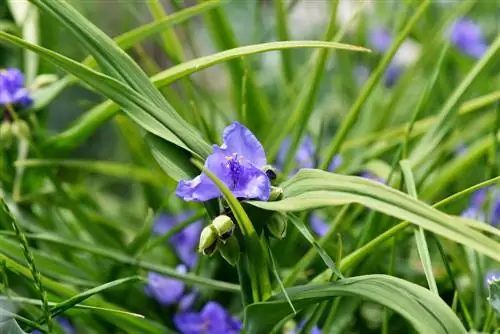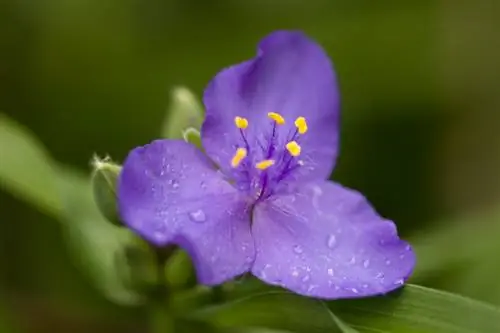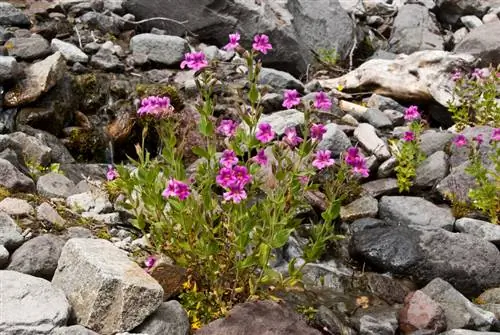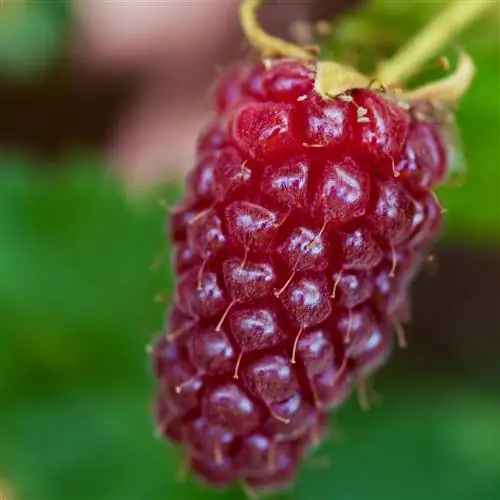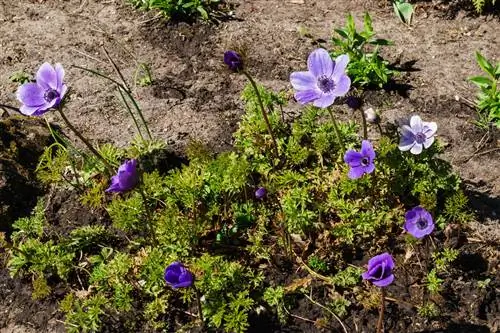- Author admin [email protected].
- Public 2023-12-16 16:46.
- Last modified 2025-01-23 11:21.
Three-master flowers impress with their colorfully patterned foliage, which can develop not only green but also violet or white tones. The plants are suitable for various uses. With the right care, they delight every hobby gardener with their vigorous growth.

What are the best care tips for three-master flowers?
Threemaster flowers (Tradescantia) are attractive house and garden plants with colorfully patterned foliage and tripartite, different colored flowers. Top candidates for good care are: sufficient light, proper watering, regular fertilization and protection from insects and pests.
Origin
Tradescantia is a genus of plants within the commeline family that has the German name three-master flowers. There are numerous species that are cultivated as houseplants. The garden spiderwort (Tradescantia x andersoniana) is widespread in gardens.
The original distribution area of the three-master flowers is in the Neotropics. Its range extends across the entire American continent, where it occurs between southern Canada and northern Argentina. It grows in the West Indies. The genus Tradescantia includes both representatives of temperate climate zones and species of tropical habitats. Here they grow in sparsely wooded deciduous forests, prairies and plains as well as in fields.
Growth
Dreamflowers grow predominantly in a creeping to slightly upright manner. Some species develop long shoots that climb up surrounding vegetation. They reach heights of between 30 and 60 centimeters and occur individually or in small groups of several plants. Most species are extremely fast-growing and form dense clumps within a short period of time. Three-mastiff flowers produce a clear and thick juice in the parts of the plant.
Bloom
The plants develop threefold flowers that appear wheel-shaped. Its petals are colored white, pink, purple or blue, while the anthers in the center glow yellow. The flowers are not particularly long-lasting. After half a day they wither and are replaced by new flowers. There are species that only open their flowers when the sky is overcast. As soon as the sun shines on the flowers, they close. The flowering period extends between May and September.
Fruit
After the flowers have withered, three-mastiff flowers develop capsule fruits. These consist of three chambers, each filled with one or two seeds. When the fruit ripens, the capsules burst open and release their seeds, which spread with the wind.
leaves
Three-master flowers develop leaves with a long and thin or slightly fleshy leaf blade. It has a shovel-shaped to lanceolate shape and, depending on the species, is between three and 45 centimeters long. They are simple in structure and have a smooth leaf edge. The leaves are colored differently. The color spectrum ranges from green to violet, cream and pink to white. Many ornamental plants develop striped leaves.
Usage
Tradescantia species have a variety of uses. Species with long drooping shoots are popular plants for hanging baskets. They quickly form a dense curtain composed of aesthetically colored leaves. Winter-hardy representatives of the genus are suitable as ground cover. They are used to plant bank areas and pond edges. Upright growing species look good in perennial beds.
These are suitable planting partners:
- Loosestrife
- woman's coat
- Pipegrass
- Iris
Poisonous
Some species in the genus can cause an allergic reaction in cats and dogs. It manifests itself as reddened skin, which is associated with itching. These mildly poisonous species include Tradescantia albiflora, Tradescantia spathacea and Tradescantia pallida. All other species are considered slightly poisonous, although no symptoms of poisoning have been described. Sensitive people should wear gloves as a precaution.
Location
The plants grow in both sunny and partially shaded locations. Some species rely on several hours of sunshine per day because their shoots wither in locations that are too dark and the leaves lose their decorative coloring. The plants like high humidity. In their natural distribution areas, three-masted flowers prefer to grow on the edges of water bodies and in open areas with very humid conditions. These requirements make the plant the perfect plant for open spaces and waterside areas.
Temperature
Three-master flowers feel comfortable in a temperature range between 20 and 24 degrees Celsius. In winter the lower limit is ten degrees Celsius.
Earth
As plants for water margins, spiderworts prefer nutrient-rich soil that provides consistently moist conditions. The sensitive roots cannot tolerate waterlogging. A sandy substrate containing loam or clay provides optimal growth conditions.
Planting time
The ideal time for planting is spring, as the three-master flowers have enough time to take root. They can settle in their location until winter. The plants can also be planted outdoors in autumn. However, there is then a risk that the plants will be damaged in winter. You can work a root barrier into the soil directly when planting. This will prevent the ground cover from spreading unhindered.
Planting spacing
Place the plants in the bed in small groups of up to ten specimens. Make sure the planting distance is at least 40 centimeters so that the specimens can spread unhindered and develop a dense carpet.
In the pot
Cultivation in containers is advantageous for most three-master flowers, as many species are not hardy. In the pot they can spend the winter in a frost-free room or on the windowsill. As soon as the temperatures rise above 15 degrees Celsius again, you can put the bucket outside again.
Use a planter with a drainage hole to allow excess water to drain away. Cover the bottom of the pot with a layer of expanded clay or chippings. You can also use stones or pottery shards as drainage. With a high-quality plant substrate or a home-made mixture, you can provide the plant with ideal conditions for vigorous growth.
Propagate
If the clumps of adult specimens become too dense, you can propagate the plant by dividing it. This measure is ideal for rejuvenating plants that have gotten out of shape. The best time is spring, before the growing season begins.
Pick off as large a root ball as possible and dig it out with a sharp spade. Then divide the rhizome into several pieces and immediately replant the parts. The planting hole should already be prepared so that the roots are not exposed to dry air for too long.
Sowing
The plants reproduce by self-sowing if the withered flowers are not cut off. This allows them to take over large areas uncontrolled. Cuttings with ripe fruits disposed of on the compost can also spread seeds that germinate on the nutrient-rich substrate or reach other beds with it.
In autumn, mature seeds can be sown directly in the bed. In most cases, the next generation of plants does not adopt the leaf pattern of the parent plants. Many offspring develop pure white or mottled leaves.
Cuttings
Propagation from cuttings is easy for three-master flowers. Cut shoots from your plant and place them in groups of six to eight cuttings in a planter. A mixture of equal parts cocohum and sand is ideal. Make sure the substrate is well moistened.
It takes two to three weeks for the cuttings to form roots. Plant the rooted shoots in a larger planter, which you fill with substrate for adult plants.
You can also place the cuttings in a glass of water placed in a bright place. Once the roots are about three centimeters long, you can pot up the shoots. Tadescantia navicularis and Tradescantia sillamontana are prone to rot formation in wet conditions. These species should be grown in a slightly moist substrate.
Cutting
Pruning after flowering encourages three-master flowers to bloom a second time in late summer. By taking this measure you prevent uncontrolled self-propagation and wilding. As soon as the leaves have withered in autumn, you can cut the plant back vigorously. Leave the plant about a hand's width above the ground so that it can sprout freshly next spring.
Houseplants can be cut back all year round. If you need to do a radical pruning, at least a third of the plant should be left standing. Shorten shoots that have grown too long to the same length. If you want the plant to grow more densely, you can remove shoot tips regularly. The plant forms new branches below the interfaces.
You should pay attention to this when cutting:
- use sharp secateurs
- Clean the blades thoroughly beforehand
- wear gloves as a precaution
Giessen
The water requirements of plants are high. Young plants need to be watered abundantly, while older specimens can get by with sparing watering. Make sure the soil is constantly moist for young plants. The substrate should not dry out. Adult three-master flowers are watered as soon as the top layer of soil has dried.
Exceptions are Tradescantia navicularis and Tradescantia sillamontana. Both species are watered sparingly both as young plants and in older years. For these plants, allow two-thirds of the soil to dry before watering again.
Fertilize
In the growth phase between spring and autumn, the plants enjoyed regular fertilization, which takes place every 14 days. Use a complete fertilizer (€14.00 on Amazon) that is administered in a weak concentration. You do not need to fertilize the plants in winter. Potted plants are also fertilized in this way. You can give these plants a low-dose liquid fertilizer via the irrigation water.
Some slow-growing species such as Tradescantia navicularis have lower nutrient requirements. You can fertilize these plants once a month.
Wintering
Plants outdoors need winter protection. Cover the plant with a generous layer of leaves or brushwood. The three-master flowers don't mind if the foliage is 20 to 30 centimeters thick. Potted plants are moved to their winter quarters in autumn. The temperatures here should be between ten and 15 degrees Celsius. Alternatively, you can also keep the plants warm over the winter. Place the bucket on a windowsill in a heated room.
Transplanting
The fast-growing plants quickly form a dense root network that penetrates the entire pot substrate. Such fast-growing species should be repotted into a larger planter every year. Tradescantia navicularis is one of the slow-growing species. She is content with the same bucket until she is three or four years old. You can also grow this species in a shallow dish.
Diseases
Tradescantia species are welcome plants for all hobby gardeners because they are extremely robust and are rarely affected by diseases. Incorrect care measures can lead to damage. If rotten leaves are not removed, the risk of mold and rot development increases. Waterlogging causes the roots to rot. Remove the damaged plant parts and reduce watering.
Lice
Occasionally three-master flowers can be attacked by aphids. In the early stages you can remove the pests by spraying the plant. If the annoying residents have spread uncontrollably, spraying the leaves with nettle decoction will help.
This prevents aphid infestation:
- essential oils like lavender
- Savory
- Use homemade herbal fertilizers
Fungal infestation
In the winter months there is a risk that three-master flowers will be colonized by gray mold. This fungus prefers to spread in high humidity. If the plant is too dark and watered excessively, the spores will find optimal growth conditions. An infestation is manifested by a gray coating on the leaves. Remove the affected areas in good time so that the fungus cannot multiply any further. A change of location and a reduction in the amount of watering can help.
Brown spots
If the three-master flower tends to form brown spots on the leaves or dried leaf tips, the cause may be that the humidity is too low. If the plant is directly above the radiator in winter, it must be sprayed regularly with water. The plants prefer humidity between 50 and 65 percent.
Yellow spots
Green-leaved species often develop light spots in locations that are too dark. This phenomenon indicates a lack of light, because in shady locations the green pigment chlorophyll is broken down and other pigments emerge. Tradescantia fluminensis often tends to develop yellow spots in the wrong location.
Tip
The beautiful leaf markings and colors only appear when the plant receives enough light. Give your plant a location where the sun shines for a few hours. If the place is too dark, the leaves lose their markings. They are becoming increasingly green.
Varieties
- Innocence: Good frost hardy. Very long flowering period between May and September, flowers white. Growth height 40-50 centimeters.
- Gisela: Grows loosely upright, forms bushy clumps. Blooms from June to September, flowers white. Growth height 40-50 centimeters.
- Leonora: Forms compact clumps. Blooms between May and September, flowers dark purple. Growth height 35-40 centimeters.
- Sweet Kate: For partially shaded locations. Flowers between June and July, developing a second flower in September. Flower color violet to blue, foliage yellowish. Growth height 30-40 centimeters.
- Tradescantia navicularis: Develops creeping shoots, growing slowly. Leaves two to three centimeters long, copper-green and strongly keeled. Underside of leaf marbled purple. Flowers light pink.
- Tradescantia sillamontana: Forms oblong-oval, six centimeter long leaves, colored peppermint green. Plant woolly hairy. Flowers purple pink.

